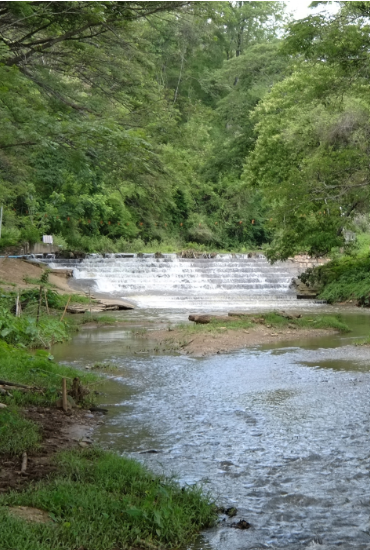Reading and interpreting the cultural landscape of Lanna agricultural communities in Mueang Khong basin, Chiang Dao district, Chiang Mai
Keywords:
reading and interpreting, cultural landscape, Lanna agricultural communities, Mueang Khong basinAbstract
This paper aims to identify the value and importance of cultural landscapes by reading and interpreting the study area, which is located in the transition zone of the Doi Luang Chiang Dao biosphere reserve. This area serves as a residence for the Lanna agricultural communities and aligns with the Lanna agricultural society concept. The research addresses how to approach reading and interpreting the cultural landscape in the study area and what values and significance can emerge from this application. The methodology involves active engagement in qualitative research, encompassing literature reviews and field surveys, which include cultural landscape surveys and non-structured interviews with four agricultural communities and 20 informants as the samples. This study found the Lanna agricultureral landscape communities are emerged by the locals’ active management of the natural environment in the valley plains to support their livelihoods, including constructing houses, farming, utilizing social spaces, managing water, and using forest resources. It highlights the interactive relationship between humans and nature, facilitated through the utilization of space and cultural practices. Therefore, the cultural landscape represents the Lanna agricultural communities such as; showcasing its historical, culture, biodiversity, ecosystem diversity, education, economic, tourism, aesthetic, and social and community values, especially in rice farming which is, the primary livelihood of these valley communities approach.
References
Amloy, A., et al. (2022). Karn sueksa phum that phuen thin lanna nai boribot chumchon khong nakwichakarn Thai nai prathet Thai chuang phoso 2545 - 2564. (In Thai) [The study of Lanna vernacular landscape in the community context of Thai scholars in Thailand during 2002-2021]. Landscape Architecture Journal, 4(1), 62-81.
Berkes, F. (2007). Community-based conservation in a globalized world. Proceedings of the National Academy of Sciences (PNAS) (pp.15188-15193). Washington D.C: PNAS.
Boonkham, D. (2020). Wa duai phumi sathapattayakam botkhwam khat san nai rop sam thotsawat. (In Thai) [On landscape architecture: selected essays in 3 decades]. Bangkok: The Association of Siamese Architects under Royal Patronage.
Folke, C. et al. (2010). Resilience thinking: integrating resilience, adaptability and transformability. Ecology and Society, 15(4), 1-9.
Jackson, J.B. (1984). Discovering the vernacular landscape. New Haven: Yale University Press.
Karnthak, A. & Weerataweemat, S. (2015). Phumi that watthanatham khwammai phatthanakarn thang naeokhit lae thit thangkarn sueksawichai. (In Thai) [Cultural landscape: meaning, conceptual development and research direction academic]. Journal: Faculty of Architecture, Khon Kaen University, 14(2), 1-12.
Kerdsiri, K. (2014). Ong ruam phum that watthanatham chumchon lae sathapattayakam phuenthin ruean thiyuasai nai lumnam thalesap Songkhla. (In Thai) [Holistic cultural landscapes of community and vernacular architecture in the area of Songkhla lake watershed]. NAJUA: History of Architecture and Thai Architecture, 11, 176-213
Klianglam, M. (2021). Karn borihan karn phatthana chumchon kasettakam samaimai bon than sangkhom Lanna Thai. (In Thai) [Management of modern agricultural community development based on Lanna Thai society]. Journal of MCU Haripunchai Review, 5(2), 59-70.
Lennon, J. & Mathews, S. (1996). Cultural landscape management. Canberra: Australian Alps Liaison Committee.
Meinig, D.W. (1979). The beholding eye: ten versions of the same scene. In Meining, D.W. & Jackson, J.B. (Ed.). The interpretation of ordinary landscapes: geographical essays (pp.33-48). New York: Oxford University Press.
Meinig, D.W. & Jackson, J.B. (1979). The interpretation of ordinary landscapes: geographical essays. New York: Oxford University Press.
Ongsakun, S. (2010). Prawattisat Lanna. (In Thai) [History of Lanna]. Bangkok: Amarin.
Peirce, F.L. (1979). Axioms of the landscape: some guides to the American scene. New York: Oxford University Press.
Spirn, A.W. (1998). The language of landscape. New Haven: Yale University Press.
Taylor, K. (2016). Research in landscape architecture. n.d.: Routledge.
Thongmee, O., Rodhetbhai, C. & Siltragool, W. (2015). Lanna food: the cultural management strategy for the creative economy development. Silpakorn University Journal of Social Sciences, Humanities, and Arts, 15(3), 105-119.
Tuan, Y.F. (1977). Space and place: the perspective of experience. Chicago: University of Minnesota Press.

Downloads
Published
Issue
Section
License
Copyright (c) 2024 Faculty of Architecture, Chiang Mai University

This work is licensed under a Creative Commons Attribution-NonCommercial-NoDerivatives 4.0 International License.


